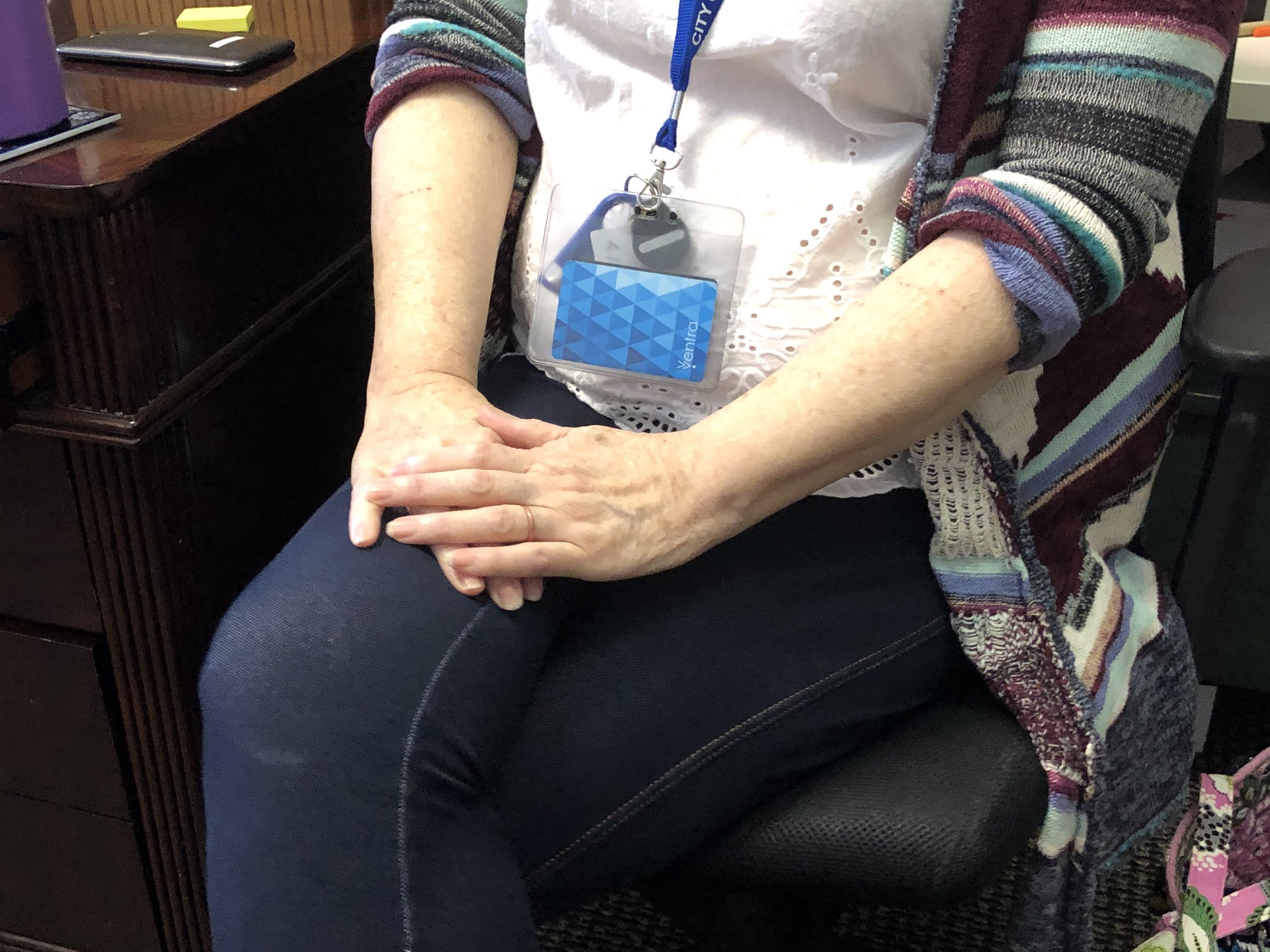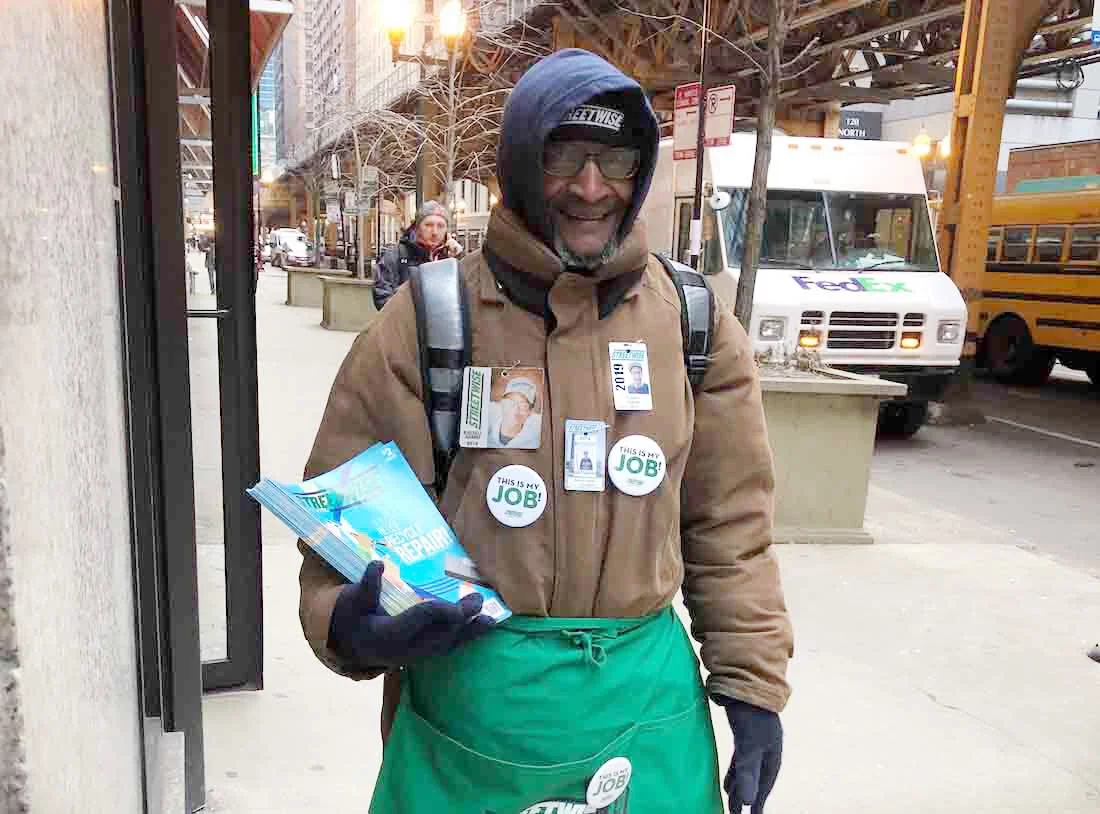To the Street and Back: One Woman’s Journey
In February 2019, an older woman with silky white hair cascading around her shoulders approached a faded red brick, middle-rise building in Lincoln Park. A maintenance worker led the woman up to the sixth floor of the building, and opened the door. The woman saw two large windows with painted teal frames, white painted walls and tile floors. The one-bedroom apartment was quaint. The woman, 64, sat on the commode, the only seat in the place, and took in the scenery. After nearly four years of being homeless she would have a place of her own again.
Let’s call her Samantha (she asked to remain anonymous to protect her privacy). After more than 50 years of a life most would consider normal, Samantha found herself living on the streets of Chicago for nearly four years. The perfect storm of loss, depression, unemployment and powerlessness pushed her out of her own life. Her story is one of many that echoes the fragility between having a home and not. Her experience was at times frightening and grim, but she points out that many have it worse than she did. She found camaraderie and support from unlikely sources and kept her whimsical spirit alive. Samantha constantly moved forward, helping others along the way, and her compassion and determination led her to a home. This is her story.
Samantha sits in an office in South Loop and tells her story. (Madison Yauger)
Who She Was
Born in the South, but bred in Chicago’s Southside, Samantha was an only child in a middle-class family. Her parents were from Alabama, her mother grew up among “Baptist-y” folk, her father, among moonshiners. “My childhood was very typical …Beaver Cleaver,” she recalls. “My mom didn’t wear pearls, but she took care of the house and the dog.” Her father worked for a union and Samantha remembers helping him type up grievances when she was 15. They had a German Shepherd called Kelly who would sleep on Samantha’s twin bed at night, even to the point of pushing her to the floor. She and a friend traveled through California when they were in high school, traversing the state in 10 days. Samantha attended college briefly at Chicago State University for a teaching degree in music education, before getting married at 19 and dropping out after her first miscarriage. She says this is when her depression began, although it wasn’t labeled as such at the time.
Samantha and her husband got divorced after 15 years of marriage, and several more miscarriages, the last of which would have been twins. “Does it make me sad? Yeah.” She moved back in with her parents during her early 30s and filled the house with animals, nine cats and four dogs over the course of many years. She tried to go back to school, enrolling in Governors State University for a degree in health administration, but her father had a stroke in 1993, which sent her education dream “to hell in a handbasket,” she said. He passed away three years later. “I’ve been back to school three times, but it’s like I never could figure out what I want to be when I grow up,” she said.
Samantha worked in management and at office jobs until her mom died of old age in 2007. Never having been close to her extended family, Samantha fell further into a serious depression without relatives to lean on. “I basically hibernated for two years, living off my 401k.” In her mid-50s, Samantha mustered the strength to go back to work and held down an admin job for a couple of years. “When the place I was working at closed, I kind of…” she paused. “I just kind of… lost it all. I couldn’t pay the taxes on my house. I lost my house. I didn’t know about all these resources that are out there to help prevent people from losing their homes.”
A friend’s mother was moving to a retirement facility, and let Samantha stay in her old house for a year, but tension grew as her friend encouraged Samantha to get help that she was not yet ready to accept. Samantha felt she needed to stand on her own two feet, so in April of 2016, she got on a train and rode downtown.
What She Did
At first, she stayed by a Dunkin Donuts near Northwestern Hospital. After a few weeks, she relocated to the Dunkin on Lake Street, by State and Wabash, and met some other homeless people who gave her the 411 on how to get food and clothes. “One thing about being out on the street is you’re free. You have no obligations, no responsibilities, nothing. It’s very liberating.” The first burden she encountered was the physical discomfort. She was in her late 50s at the time and has a congenital back issue, so the constant stiffness was not improved by sleeping on the concrete. Her legs swelled up during the first few months, and she still has residual aches.
Samantha is objectively a pleasant conversationalist and makes friends easily. Soon enough, she and the girl who worked the overnight shift at Dunkin became friends. The girl would keep an eye on Samantha while she and a few other homeless people slept on the sidewalk. Samantha said she never asked to stay inside, because she didn’t want to push her luck. The morning manager was not as kind. When she arrived at 5 a.m., she would yell at the homeless for being outside the store. Samantha began setting an alarm for 4:30 to wake the others before the manager arrived. Sleeping outside was unsettling for Samantha. Apart from the train noise and people walking by, there was no sense of security. One morning she woke up with a line of Cheetos next to her stomach, unsure how they got there. She lived unsheltered for almost six months.
Without an address, receiving mail is challenging. Many homeless people list a social service, church or friend as their mailing address. For example, in Chicago, the Department of Human Services allows homeless people to use them as a mailing address for a limited period of time. Samantha didn’t receive mail until she arrived at a shelter.
Samantha became savvy about where to go to wash and use the facilities. “You get to know where the bathrooms are, like at Millennium station, if you go in a little further by the tracks, there’s a smaller bathroom with five or six stalls, and there’s less traffic so you can have a little more time.” She explained that some employees didn’t like her using the bathroom and would call security to ask her to leave. “You have to be polite.” She mentions that because she’s older with white hair, she never had any issues when being asked to leave, but encounters between security and those with serious mental illness don’t always go as smoothly.
This Dunkin Donuts provided momentary refuge for Samantha for the six months before she got a tent. (Madison Yauger)
As someone who herself suffers from depression, Samantha was appalled at the number of people living on the streets with mental health afflictions. “There was this lady who used to come into the train station, and I called her ‘Shut Up Shirley.’ It took me a long time to realize she wasn’t on the phone because she would have these conversations and just shout, ‘SHUT UP, SHIRLEY.’ I realized Shirley was this imaginary person, who would interrupt her. She was a nice woman, but obviously she doesn’t belong out on the street. It adds more fuel to it by the fact you’re not sleeping right, you don’t have housing or security.”
In June 2016, Samantha met a woman named Roberta Rogers. Rogers herself was struggling with homelessness, but was living with a friend at the time and volunteering with an organization that passed out food and supplies to the homeless. “When I saw Samantha, I could tell she was a newbie to the streets,” Rogers said. “She was acting tough, but shaking and I could tell she was going to fall apart.” It had begun to rain that afternoon, so Rogers asked Samantha to join her in the car going around to give out supplies. Samantha was hesitant, but came along and eventually broke down crying. After that, Rogers met with her once a week on and off for three years. The women remain close friends today.
As Rogers will attest, Samantha constantly sought out ways to help others, even when she was in need of help herself. She says she began volunteering for aid organizations, as well as signing up for advisory boards of policy organizations such as All Chicago Continuum of Care (widely known as CoC), to act as a voice for the homeless.
Samantha had a hard time accepting money from passersby, and would only take the bare minimum to get by. She gained income from signing up for paid surveys and studies, receiving small stipends from some of the advisory boards she sat on and her 401k.
In October, she prepared for her “first move” to a “tent city” in a grassy area near the river past Roosevelt Road and Wells Street. A church organization in Tinley Park gave her a tent. On moving day, Rogers picked Samantha up with a couple of kids from her nonprofit and worked with local photographer Lloyd DeGrane, who has street cred in the camp, to sneak her in. “I asked my friend Jimmy if he would mind if she pitched her tent near him,” said DeGrane. “He’s a pretty nice guy, and I assumed he would look after her.” Her tent sat on a hill -- “the suburbs” of tent city, and remained out of the way. Samantha slept for the first two days. “I’d check up on her every once in a while,” said DeGrane, “and she seemed to be doing well. She was quiet, and people didn’t know her very well there. She kind of kept to herself.”
Samantha says she found camp life interesting. She had shelter when it rained and her own designated space. Sometimes Jimmy would leave offerings such as a t-shirt outside her tent and she would leave him peanut butter sandwiches. One time Samantha was brushing her teeth behind a bush and a tourist boat came by and people waved at her. “I’m glad I was just brushing my teeth!” she said. Spitting toothpaste near her tent would attract rats. “The rats were HUGE. They chewed through my tent!” On more than one occasion Samantha encountered the furry nightmares. “I love men, don’t get me wrong, but they have this unrealistic opinion of themselves.” Samantha was assured by several men near her that if she needed anything they would help. One night, a rat crawled into her tent and Samantha started screaming. “I unzip the door and it’s running around my tent and finally it leaps on my shoulder and catapults itself out of my door. Did the guys hear any of that? Of course not.” Samantha shakes her head. “It certainly wasn’t ‘glamping.’”
In December 2016, the city asked the tent city residents to relocate due to landscaping projects in the area. DeGrane and the Night Ministry, a local non-profit, got Samantha into the San Jose Obrero Mission shelter in Pilsen, an SRO facility with two women to a room. As a single woman and a non-addict, Samantha was a good fit for the shelter, said DeGrane. She stayed there a year. Obrero had a kitchen and the residents would cook sometimes, but they also served dinners there, mostly chicken. “We had so much chicken we used to joke that we could be laying eggs.”
To help buy her own food, Samantha has a Link card, the Illinois system for administering SNAP or food stamps. She often shopped at Mariano’s, which she praised for being accessible and having solid options for those who don’t have regular access to food. “They have pre-cooked food, and they will also cook your food, like a pork chop. I would get a bagel and a few pieces of lunch meat. They have condiments at the tables, a toaster and microwave, too.”
Still, the shopping experience could sometimes be awkward. “I was in Mariano’s. I had picked out these two donut peaches. They’re a little bit pricey. As I was checking out I said, ‘I really shouldn’t be buying these but they’re so good I needed to treat myself, right?’ And I slid my Link card to the cashier, and she said very loudly, ‘Well, it’s free money anyway!’ The guy behind me said, ‘What?’ And she said, ‘Yeah, she’s using her Link card!’ I wanted to sink through the floor. I made sure not to go to that cashier ever again.”
Obrero closed in February 2018, setting Samantha up for her third move since becoming homeless. She went to Cornerstone Community Outreach shelter, North of Wrigley Field, and more specifically stayed in Naomi’s House, the women’s only section of the shelter. Eighty women lived in barrack-style twin beds, two feet or so apart. There were three sinks, shower stalls and toilets. A few transgender people lived in the shelter, and some women complained. Samantha scoffed at the complaints. “It’s not about the package, it’s what’s inside,” she said.
Throughout her year-long stay at Cornerstone, Samantha stayed on the hunt for housing. “The CoC says they can house people right away, but it’s just not true. Honestly the stars have to align.” Case managers at Cornerstone and the Chicago Housing Authority helped her fill out a coordinated entry, a new system that helps place homeless people with appropriate housing organizations. In February 2019, she got an email saying she could come down for an interview at Lincoln Park Community Shelter.
The maintenance woman who showed Samantha the Lincoln Park unit apologized about the debris on the counter, the un-waxed floors and the empty spaces where new appliances would soon be arriving. “You just don’t understand,” Samantha told her. “You have no clue what I’m coming from. This is wonderful.” Then Samantha hugged the woman. “I was excited. I was nervous and scared. I thought, ‘Can I do this? Pay the electric bill on time? Pay rent on time? Handle these responsibilities again?’” said Samantha, recalling her self-doubt. On March 19th, 2019, she signed her lease. Her rent is subsidized by the Chicago Housing Authority.
Who She Became
Three months later, Samantha is still settling into her new space. An air mattress is the only furniture in the apartment aside from a table that’s still in the box. She’s trying her hand at cooking again, but has already had a few mishaps involving burnt plastic. “My oven hates me,” she said with a smile. Once again determined to take care of someone besides herself, she got a four-month-old Chihuahua she calls Sasha. She still sits on advisory boards for different homeless-related organizations and shares input on what will do the most good, using her experience as a guide.
“Samantha got off the streets because she was determined and focused,” said Rogers. “She had housing and stability in her childhood and adulthood, and knew she had something to go back to.”
Samantha still struggles with depression. “When you’re depressed, sometimes you feel somewhat suicidal, and you’re like, well, I can’t kill myself now, I have this damn dog. I haven’t thought about that in a very long time.” She nervously laughs. “And even when I did think about it, taking all the pills in my purse or getting in the bathtub, I’d think, well, what about the person who has to clean all that up? That’s not nice to them. Then I thought, well, just step in front of a bus or train, but then I thought that will traumatize the poor driver! Don’t do that!
“Do I put myself first? Not necessarily. Is that the brightest thing to do? Not necessarily. It’s like they say on the planes, you have to put your own oxygen mask on first before you should help others, but that’s… I have no idea why that’s the way I am. I have no clue.”
Rogers agreed with Samantha’s self-analysis. “The driving force was and still is her compassion for others,” said Rogers. “She would always say, ‘I’m okay. How are you? What can I do for you?’ She’s really passionate about the rights of others. She’s not afraid to use her experience to help others.”
Samantha wants to get her Certified Recovery Support Specialist certificate, which would qualify her to give peer to peer support, though the certification requires over 2200 hours of supervised work. She says having a friend to support you makes all the difference. She acknowledges that there are two reasons she was able to break out of homelessness. People were willing to extend their hands, and she was willing to reach back.
“There are people who’ve been out there for 20 years. It’s heartbreaking. I didn’t see that, when I was a ‘homed’ person. I didn’t see that. I, myself, averted eyes. Twenty or 30 years ago, I saw a guy panhandling. I finally looked at him and said how about I get you lunch. We walked into Wendy’s and the lady looked at us. He said what can I get? I had a halfway decent job at the time, so I said to get whatever he wanted.
“But, I never thought about how these people got there. I never thought about who they were before. I never thought about who they could become. And I think that’s a big issue, is that people don’t always see the person.”







